VIVA BAJA!
HOW TO PULL OFF A D.I.Y. TRIP FOR THE EXOTIC SPECIES OF THE STORIED SEA OF CORTEZ
By Tim E. Hovey
LA PAZ, Mexico—As a boy, I used to listen to my grandfather talk about Baja California – specifically the Sea of Cortez, also known as the Gulf of California – frequently.
At the time, I thought he had been there. As it turned out, all he knew of the desolate peninsula and the beautiful blue sea came from a book entitled The Sea of Cortez, written by Ray Cannon, and published in 1966.
My grandfather would talk of huge fish being caught from the beach, and devil rays weighing close to 1,000 pounds leaping from the blue waters and smashing back to the surface with a thundering slap. I would pour through that book every time I visited him, marveling at the size of the fish that swam the gulf. Even as a young boy, I knew I wanted to go there.
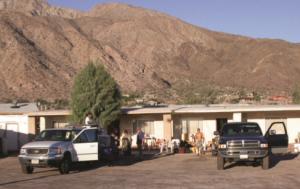
A DREAM FULFILLED Starting in the early 1990s, I started making frequent trips south of the border to experience the Baja Peninsula. Those first trips were required during my fisheries’ training. The university I attended maintains a field station called Los Pulpos, about 30 miles south of the coastal town of San Felipe. During my early college days, I made regular trips down to the field station, located scant feet from the calm gulf. Once I became familiar with portions of the peninsula, all I wanted to do was see more. I learned two things very quickly once I started traveling to Baja: the beaches and surrounding terrain of the peninsula were wide open for exploration, and the fishing in the Sea of Cortez was absolutely amazing.
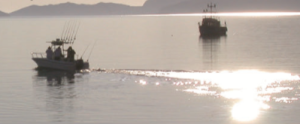
THE
Once our field work was complete, we’d often fish the shore or take one of the school vessels out and fish the channel. It really didn’t matter where we went on the gulf; we caught plenty of fish.
From the remote Enchanted Islands in the northern part of the gulf, to the brilliant blue waters of East Cape further south, I’ve spent a great deal of time in Baja, fishing and diving in the Sea of Cortez.
I’ve towed boats down the entire length of the peninsula, stopping off at remote beaches to launch and explore the rugged islands off the coast. I’ve even fished the areas described in Cannon’s book, feeling a strong connection to that modern day explorer. I’ve caught almost all the species listed in his book.
THE SEA OF CORTEZ AND ME
“Down through the ages, adventurers and poets alike have had their fancies tickled by the mystery of uninhabited islands. Man has traveled the lands and seas, searching out and exploring almost every bit of the earth’s surface, and now is turning his eyes to other planets. But here in the Cortez are fantastic bits of land that have been ignored for centuries. There are a hundred little-explored islands and as many pieces of land of various shapes and sizes that could be called islands. Even those that appear as dots on a map may take half an hour to circle in a boat and even longer to scale.” –Ray Cannon
From my first early trips to the Sea of Cortez, I wanted to explore these islands that Ray Cannon described. I’m proud to say that, during my travels, I’ve had the opportunity to have a shore lunch on several of these rugged, untouched offshore land formations. –Tim E. Hovey
PLOTTING YOUR TRIP About 30 miles south of the university field station is the abandoned fishing village of Oke Landing. Little more than a rock-covered cove with several old cement foundations, the remote location is perfect for staging a base camp and fishing the offshore islands. We’d launch our skiffs in the town of Puertocitos and run the coast to the campsite, setting up camp for a week, essentially surviving on whatever we could catch.
Huge schools of yellowtail cruise the offshore island channels, easily teased into striking trolled Rapalas.
Triggerfish, leopard grouper and spotted sand bass thrived in the coastal waters and were regular fare for camp lunches and dinners for our adventurous group. Armed with spear guns and pole spears, we’d fill our stringers with gray bar grunts and fine scale triggerfish right off the beach. Oke Landing is definitely off the beaten path, but it remains one of my favorite gulf destinations.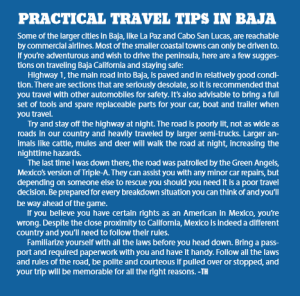
Continuing south, inland from the large Archangel Island, you’ll find the Bay of Los Angeles, a small fishing village located at the base of the coastal hills. The town itself has limited amenities, but five-star accommodations are not the reason you travel to Baja.
The waters surrounding the offshore islands are home to grouper, yellowtail, dorado, tuna and several species of bottom fish. During the summer, when the water gets warmer, tuna and sailfish can be encountered in the deeper island waters.
For the most part, the ocean conditions are serene and calm in this section of the Gulf of Mexico. However, seasonal winds can descend on the area in an instant and turn the flat, calm seas into hazardous conditions for smaller crafts. Whenever I head to this area and fish
offshore in a boat, I keep one eye on the horizon and pay close attention to the activities of the locals. If I see their boats heading in during midday, I head in during midday.
Further south is the small beach town of Punta Chivato. The village offers a clean camping area and a protected harbor. The shallow reefs offshore offer some amazing diving and the standard nearshore species of triggerfish, cabrilla and spotted sand bass are easily caught from the manmade jetties. Offshore species like dorado and yellowtail can be encountered out around the islands or near the shark buoys; baited hooks and anchored floats are set out to catch sharks.
THE SEA OF CORTEZ AND ME
“The subject of angling should be treated with profound thought, for it is one of the most vital branches of culture. It is a source of humor, but it also evolves a deep and rewarding philosophy. It is a suspenseful drama, a game of skill, a sport, an art, and a most pleasurable avocation. Angling is all of these and more, for it is an escape from fictitious society to reality, an escape from tensions, grating sounds, and frightening speeds to true, long-lasting serenity.” –Ray Cannon
Only true anglers will appreciate this statement. It has never been about the catch, the battle or the number of fish; for me, it has always been about disengaging from responsibility and recharging. –Tim E. Hovey
THE ULTIMATE FISHING SPOT
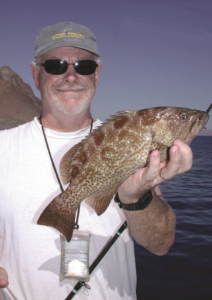
About three-quarters of the way down the peninsula you hit the fish hook: La Paz. In the early 1990s I started making regular trips to La Paz to fish the fertile waters surrounding Cerralvo Island. In my opinion, La Paz is the gateway to some of the best big-game fishing on the planet. After a quick stop at the island shallows to collect bait, quality fishing is minutes away.
Sailfish and marlin are frequently seen at the surface, warming themselves in the gulf waters. Dorado and yellowfin tuna are standard species encountered for most of the year.
Massive amberjack swim the deeper waters, taking a firm spot as one of the top predators of the gulf. Bright red pargo and dogtooth snapper patrol the shallows of the island, and will find the safety of the sharp rocks and cut your line nine times out of 10 when hooked.
Offshore, boat captains keep a sharp lookout for activity at the shark buoys. Dorado feed at the buoys and are easily enticed to take a live bait or trolled lure. One of the fastest growing game species, dorado are strong fighters when hooked and will often display spectacular jumps in an attempt to escape. And if I had to eat one species of fish for the rest of my life, it would be dorado.
About 50 miles south of La Paz is the coastal town of East Cape. Three main resorts sit right on the gulf, providing access to more fantastic Sea of Cortez fishing spots. Most of the species of gamefish are present most of the year.
Pangas and luxury cruisers can be booked and boarded for half-day and multi-day fishing trips only yards from the beach resorts. Marlin, sailfish and tuna can be caught within site of your hotel.
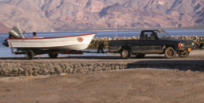
After a full day of fishing, snorkeling the crystal-clear waters right off the beach is an awesome way to unwind. I’ve made dozens of trip down the Baja Peninsula over the years, and it is one of my favorite spots to be. If you get away from the border towns, the scenery is absolutely beautiful. I’ve always looked at traveling to some of these desolate areas as all part of the adventure. You can find plenty of local food stands along the way in some of the bigger towns; gas station availability also seems to increase every year.
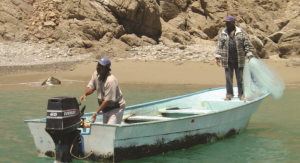
If you’ve never been south of the border, take the time to investigate all you can about traveling in Mexico. There are plenty of good tour books that are a must for new travelers.
Ask people who have been there before and be prepared before heading out. If you enjoy new places and amazing angling, the adventure of Baja is worth considering. All you have to do is get there. CS
THE SEA OF CORTEZ AND ME
“Somewhere in warm waters of the earth there may be a region where more kinds of game fish occur, or there may be a greaternumber of one or two species than in the Cortez, but I have heard of no place where so many fine gamesters are so abundant.” –Ray Cannon
This sentence would scream to any angler. And as a young boy, the colorful photos and descriptive stories in The Sea of Cortez completely hypnotized my young mind; I seriously had adventurous dreams of fishing the gulf. When I finally began angling here and hooking big fish, I would silently thank my grandfather for giving me Ray’s book – and Ray Cannon for writing it. –Tim E. Hovey



